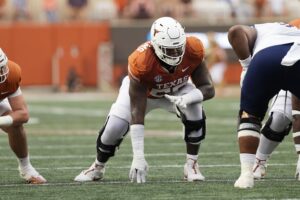Prior to their thrilling 30-28 win over the Houston Texans, the New Orleans Saints had lost their previous five regular season-openers. While there were various causes for each of those losses, one commonality was a big passing day for the other team. The Saints secondary allowed at least 300 yards passing in each of those losses, including 417 yards allowed to the Tampa Bay Buccaneers last season, and 445 surrounded to the Atlanta Falcons in 2015.
These ugly performances followed New Orleans well into the season, and they finished near the bottom of the league in passing yards allowed in each year except 2017. That year, they managed to clean up many of their issues by midseason and finish 15th overall.
At times it may have seemed like New Orleans was well on its way to allowing another huge passing performance, but Houston finished with a modest 234 yards through the air. That number was reduced from 268 yards of passing from Deshaun Watson thanks to six Saints sacks.
Along the way, there were plenty of mistakes in coverage, but also signs that the Saints secondary may be in for a better year than the last five.
Here’s a detailed look at the good, the bad, and the ugly from the Saints secondary in week one.
New Orleans Saints Secondary Turns in Mixed Debut Performance
The Good
Forcing Watson to Attack the Middle
A furious Saints pass rush early in the game and physical play from the defensive backs prevented Watson from completing a pass on his first five dropbacks. On a 3rd and 14 on Houston’s second drive, the offensive line finally managed to contain the rush, but the Saints secondary was able to pick up the slack.
Prior to Watson’s throw, all three of his wide receivers were at, or beyond the first-down marker. However, New Orleans held its zones well and none of the receivers were open. Watson had to dump the ball off to running back Duke Johnson for a six-yard gain and Houston punted for the second time.
In general, New Orleans did a good job defending intermediate routes, especially on the outside. Watson was forced to test the middle of the field for much of the game and often forced throws to wide receiver DeAndre Hopkins.
13 of Watson’s 28 targets went to Hopkins, five of which fell incomplete. Six targets went to running backs for a total of just 33 yards. While receivers Will Fuller and Kenny Stills gained a combined 106 yards, Watson completed only five passes to them, two of which gained less than four yards.
This all might not seem that impressive and the Saints pass rush helped by consistently limiting the time Watson had to read the field. It was nonetheless encouraging to see New Orleans reduce Watson’s options effectively in their first regular-season action. This is notable progress from their past five debuts.
Marcus Williams Interception
This play was perhaps the most momentous of the entire game. New Orleans had cut the Texans lead to 21-17 late in the third quarter, but Houston’s offense had scored on its last three possessions. It was the perfect time for a turnover.
On a third and eight, Fuller ran downfield along the seam from the slot before angling towards the sideline. Nickel back P.J. Williams missed his jam at the line and quickly fell behind in his pursuit of Fuller. Marcus Williams played a deep zone shadowing the opposite side of the field, but began creeping across when Watson’s head turned to Fuller’s side.
Once Watson began to throw, Marcus Williams turned on the jets and found the right angle to undercut Fuller’s route. Then Williams turned his eyes back upfield, located the ball and arrived at the perfect time to make a leaping interception.
This is the type of play Williams made regularly in college. While he’s made six other NFL interceptions, none have looked quite as calculated or as fluid as this one. Williams also broke up two passes and finished the game as the Saints highest-graded defender per Pro Football Focus. This was undoubtedly Williams strongest season debut yet.
The Bad
54-yard completion to Fuller
The Saints had held Watson in check on the Texans first two drives but this play started to flip the script. New Orleans played a cover three with Marcus Williams in the box and Vonn Bell in a deep zone. As cornerback Eli Apple funneled Fuller towards the middle of the field from the left side, Bell committed a serious error.
Bell seemed to completely overlook Fuller, and when Watson put his arm back to throw, Bell ran upfield toward a different route. He flailed his arms when the ball sailed over his head, realizing his mistake. Thanks to an overthrow by Watson, Apple still nearly managed to break up the pass, but couldn’t quite rip the ball out of Fuller’s hands.
There were a couple of other mishaps downfield that didn’t make the stat sheet. Bell nearly made up for his blunder win an interception on the Texans next drive but misjudged the pass. He correctly picked up a Hopkins route from his deep zone but came up too far. The pass went just over Bell’s hands as he reached up for the interception, but fortunately, Hopkins was unable to hold onto it.
Later in the second quarter on a third down, Fuller ran a corner route to the end zone with P.J. Williams in pursuit. Fuller faked out Williams at the line, preventing the defensive back from getting outside leverage. Williams had to grab Fuller to get back outside, and the referee noticed and threw the flag. This gave Houston a new set of downs and they scored on a touchdown pass to Hopkins.
Hopkins Touchdowns
P.J. Williams was put in a difficult position on the aforementioned Hopkins touchdown. He was playing an underneath zone from the slot and correctly passed off the slot receiver and held his zone. Behind him, Marshon Lattimore trailed Hopkins on a slant route. Before Williams could drop back far enough to provide support underneath, Watson drilled a high pass to Hopkins in the back of the end zone.
Suspect play-calling put the entire Saints secondary at a disadvantage on a third-quarter Hopkins touchdown catch. New Orleans put their 4-3 base defense on the field to contend with a four-wide receiver Texans formation. They ran a cover 4 coverage, leaving a massive opening in the middle. Hopkins simply went to the goal line on a post route, cutting inside of Marcus Williams and boxing him out for the catch.
Middle linebacker Alex Anzalone needed to be deeper in coverage to take away this lane, but that’s a lot of space to cover against a four-receiver formation. Most of the blame rests on the play-call and personnel grouping here.
The Ugly
New Orleans led by six points with 0:50 seconds left in the fourth quarter for Houston to respond. The Texans found the end zone in just 0:13 seconds.
Lattimore lined up close to Hopkins but gave him a free release. The receiver weaved downfield and got a step on Lattimore. Although Marcus Williams was in the vicinity, he was late in coming over to provide support. Watson hit Hopkins perfectly just past the Saints 40-yard line.
On the next play, P.J. Williams got out-maneuvered by Stills for a touchdown. He had Stills in one-on-one coverage from the slot and incorrectly guessed that the receiver was heading outside. Instead, Stills went on a skinny post, forcing Williams to flip his hips and lose a step.
This was suspect play-calling once again. Both Marcus Williams and Bell were in the box prior to the snap. Bell blitzed, along with six other Saints, while Williams dropped about 15 yards into a zone on the left side, well beneath the Stills route. Blitzing had worked for New Orleans for much of the game, but considering Houston needed a touchdown, the gamble didn’t make sense in that situation.
The only upside was that Houston scored so quickly that New Orleans had enough time to get into position for a game-winning field goal.
Bottom Line
The Saints coaches really challenged their cornerbacks in this game. They had their linebackers and safeties play aggressively near the line, likely because New Orleans was missing their top three defensive tackles and wanted better run support. Pressuring Watson and minimizing scrambles was clearly another goal. As a result, the cornerbacks spent a lot of time without safety support over the top or linebacker support underneath.
New Orleans was unable to contain the run and gave up 180 yards on the ground, more than they allowed in any game last season. They get somewhat of a pass on that for now considering the defensive tackle situation. However, this run success opened up play action for Houston, putting even more pressure on the secondary. Considering the situation they were put in, the Saints secondary handled the gameplan pretty well.
Next week, New Orleans travels west to face the Los Angeles Rams, another tough assignment for the Saints pass defense. This is another good chance for the secondary to show it made progress over the off-season.
Main Photo:
Embed from Getty Images






